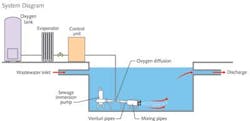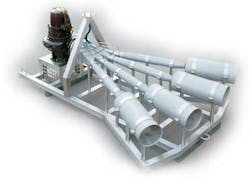Oxygen Overhaul: How to Boost Efficiency of Aeration Treatment Systems
By Stefanie Gregg
Aeration has been a primary method for treating municipal and industrial wastewater for more than 40 years. It is a natural way to control biological oxygen demand (BOD), maximize aerobic digestion of organics and control odors. As a firmly-established technology, aeration systems will continue to play a role well into the future. However, is there a way to improve efficiencies and reduce operating costs?
Some types of aeration systems are inherently more efficient. It requires less energy to inject straight oxygen (O2) than to push volumes of air into an aeration basin. Even a moderately-sized plant may treat a million gallons or more per day, and banks of air blowers and surface aerators running three-phase at 460V on a continuous basis can easily consume kilowatts per hour. Further, it is clear why electricity typically accounts for about 30 percent of a facility's operating costs.
Accordingly, multiple blowers can reduce the possibility of system-wide pumping failures. Seals fail, internals wear and pump efficiency degrades over time, and concurrently, organics and other contaminants can deposit inside and impede the flow of wastewater in conveyor pipes. Some contaminants may also corrode equipment internals.
Because blowers wear and fail at different times, replacing them all at once can be a difficult decision - one that requires a substantial capital investment with senior management support or government approval. Total replacement may become necessary with older plants or when overall wastewater treatment efficiency cannot keep up with burgeoning treatment demands due to new development or seasonal demand factors. This may involve the installation of parallel air stations to keep pace with demand. In the majority of cases, an O2 booster system can offer a cost-effective alternative to full replacement or a valuable pre-treatment supplement to an existing aeration system.
Five Times Better than Air
The transfer of pure oxygen can solve various problems without the need for complex construction. Additional oxygen transfer covers peak needs, for example, in the case of increased wastewater inflow, intensified BOD/COD, nitrogen concentration or major fluctuations in pollution loads. In some cases, treatment authorities want to move to higher treatment standards for local environmental reasons or else new demands on existing treatment systems may exceed original design capacity. Communities may also need to improve capacity due to new development in the area or simply want to improve peak sewage treatment capacity during and after storms.
Many municipal wastewater treatment problems trace back to insufficient oxygenation, and one signal of inadequate purification or anaerobic decomposition processes is offensive odors. Ideally, plants should respond to odors and other treatment problems early to avoid exceeding treatment targets or generating community complaints. Oxygenation systems are naturally much more efficient than straight aeration with air being 79 percent nitrogen and only about 21 percent oxygen. Likewise, 100 percent oxygen offers about five times the oxygenation capacity of a forced air system.
Oxygen may be injected into wastewater in a number of ways. In supplemental systems, the oxygen injection system can be installed as a pre-treatment before primary aeration or more often directly in an aerated treatment lagoon. Supplemental oxygenation is typically most effective near the effluent inlet, but multiple injectors can be positioned in a treatment pond to treat from multiple sides to achieve treatment objectives. Further, a supplemental system can quickly reduce demands on a primary aeration system and can be run continuously or just during peak treatment loads. The oxygenation system can push a lower gas volume, while treatment efficiency will be much higher. A supplemental system can also reduce the demand on the primary aeration system, thereby contributing to lower energy and maintenance costs.
Advantages of Oxygen Booster System
- Rapid solution for many odor and treatment problems
- Low-cost investment
- Improved treatment performance
- Optimized oxygen transfer and utilization
- Low maintenance
One common method of oxygen injection for municipal systems is via special gas jets (see system diagram Fig. 1). Figure 2 shows a proprietary set of gas jets for the SOLVOX® – V system from Linde for even distribution of oxygen-enriched water. Jets are easy to install in existing lagoons or treatment tanks. Installation includes an oxygen storage tank, a control system and a vaporizer unit that converts the liquid O2 to low-pressure oxygen gas. The system is engineered to match anticipated peak loads, while the control system meters oxygen to meet instantaneous treatment demands and minimizes overall oxygen consumption. The system also includes supply lines for each bank of jets and a submersible blower for each set.
Another O2 delivery method, used for treating pre-screened organic effluents in large treatment tanks, is through oxygen hoses or diffusion mats. This method is more often used as the primary oxygen treatment system, but it can also be used as a supplemental system to more tightly control BOD in aerobic treatment tanks. The specially-designed oxygen hoses and diffusion mats are useful for maximizing aerobic activity in moderate depth tanks. For deep 15-20 ft. tanks, a sidestream injection is more economical.
Oxygen hoses or diffusion mats inject O2 in a serpentine layout near the bottom of the tank. Oxygen is delivered at pressures below 100 psi and pushes through perforations, sending thousands of tiny bubbles up through the liquid (see Fig. 3). The upward flow of dissolved oxygen feeds aerobic digestion while also contributing to tank circulation. An oxygen hose or diffusion mat with 120 ft. of linear capacity may include about 300 perforations per foot, and can transfer oxygen at about 300 to 800 scf/h, depending on wastewater constituents, water temperatures and other delivery and diffusion factors. Coupled with a feedback system, monitoring dissolved oxygen levels near the tank surface can help maximize oxygenation efficiency and provide a useful gauge for suppressing odors. Gas jets or diffusion mat oxygenation systems can typically be installed in a matter of 1-2 days.
Some municipal treatment plants include denitrification, and oxygenation can provide a cost-effective way to boost efficiency of activated sludge and other denitrification treatment systems. In addition to the above methods, oxygen can be injected directly into pressure pipes as effluents flow to or from a treatment tank. Special spherical nozzles can also prevent clogging, and the type and placement of oxygen injection can vary depending on the type and configuration of the system. To reiterate, a supplemental oxygen booster system is relatively easy to retrofit. Denitrification is also worth noting, since other uses of oxygenation should be considered for site planning.
Oxygenation systems require a consistent supply of industrial grade oxygen but have few, if any, moving parts. The only external energy is dedicated to the control system (and blowers for jetted oxygen), so oxygenation uses only a fraction of the energy of an equivalent aeration system. High-purity oxygen (typically >99.5%) minimizes wear on the internals of the delivery system and helps ensure consistent treatment performance.
Municipal treatment facilities may own or lease the on-site oxygen storage tanks, and certified oxygen is supplied through an annual or multi-year agreement with a primary industrial gas supplier. Supply arrangements may include pipelines for large municipal systems or telemetric tank monitoring systems so deliveries can be automatically scheduled when liquefied oxygen drops below a specified storage level.
In short, oxygen booster systems offer a quick way to greatly improve treatment performance and extend the life of existing compressors and air-based systems. An on-site assessment and BOD testing can determine existing flow and treatment parameters, as well as define the requirements for an oxygen booster system. While oxygenation systems are sometimes used in rescue treatment, the best time to install a booster system is before seasonal peaks and well before existing capacity is exceeded.
About the Author: Stefanie Gregg is an Application Sales Engineer at Linde with more than 13 years of engineering experience in industrial and municipal water/wastewater treatment. She regularly assists water treatment professionals across the U.S. in evaluating systems for process improvement and developing strategies for peak efficiencies. Gregg earned a BS degree in Chemical Engineering from Drexel University.
About Linde: Linde is the largest commercial supplier of CO2 in North America with an extensive nationwide distribution network. The company also offers oxygen (O2) and ozone (O3) gas-dissolution systems for water treatment. The Linde Water Treatment Team reviews treatment challenges and develops complete engineering solutions for the storage, metering and injection of gases. For more information, visit Linde at www.lindewatertreatment.com, or call 800-755-9277.



